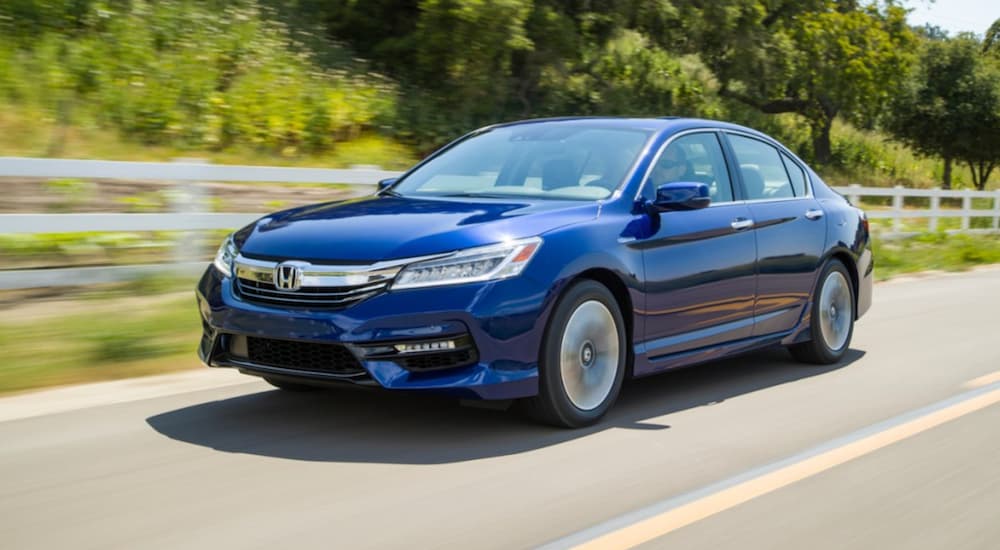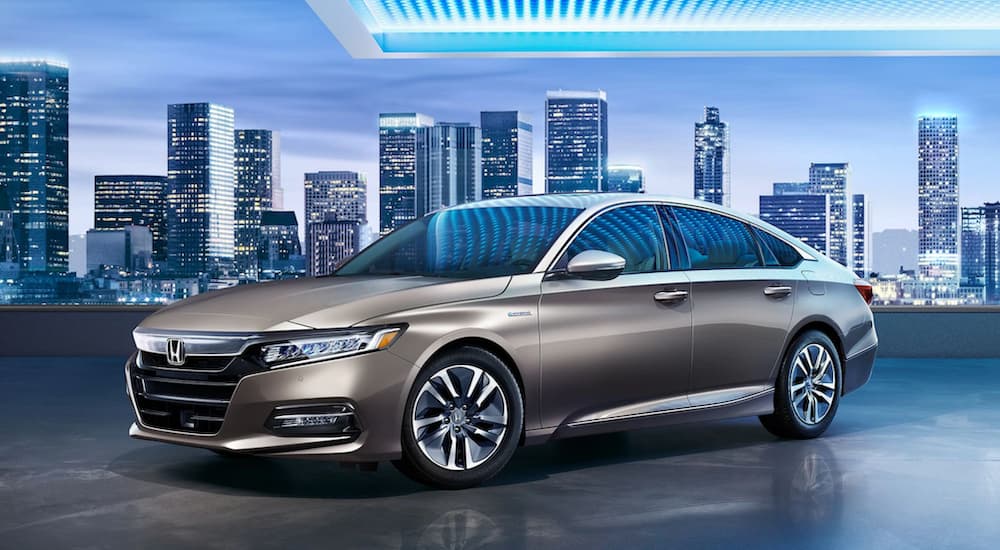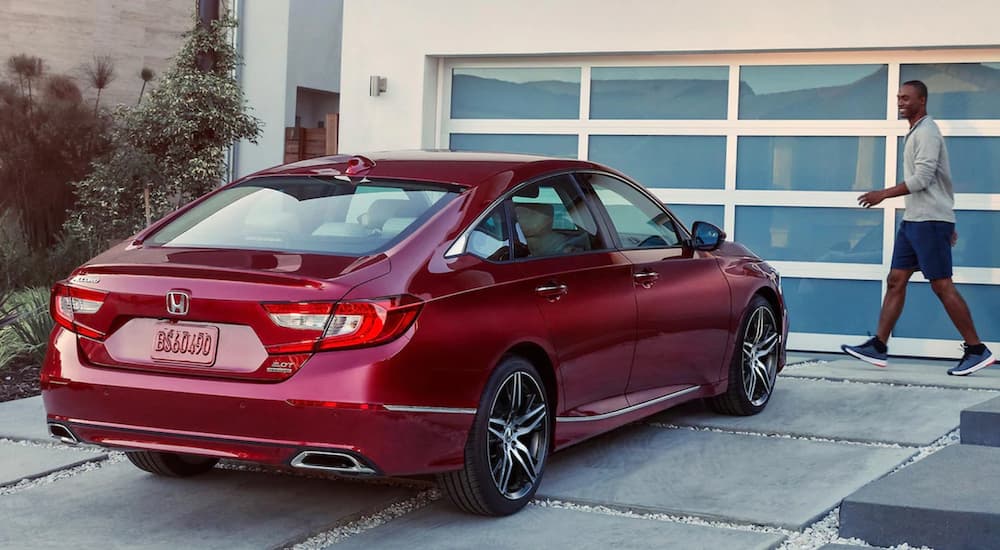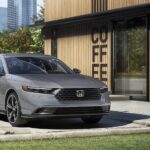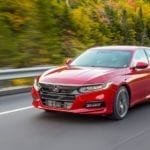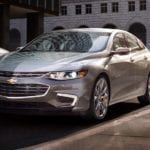If you’re looking at a used Honda Accord for sale, odds are good that it’s a tenth-generation model. This generation ran from the 2018 model year to the 2022 model year, and in that relatively short time, it brought a fair amount of changes to the popular midsize sedan. How exactly did this generation leave its mark on the model? What made it different from the generations that preceded and succeeded it, and how did it evolve over its five years on the market? We’ll answer these questions and more as we dive into the timeline of the Accord.
2017 – The Last Hurrah of the Ninth Generation
Sometimes, the tail-end of a generation will leave automotive publications saying that a vehicle feels “outdated” or “due for a refresh.” The 2017 Accord had no such issues, earning accolades ranging from a 10Best award from Car and Driver to a Top Safety Pick designation from the Insurance Institute for Highway Safety. Kelley Blue Book named the Honda Accord its most awarded vehicle of 2017 after it secured its place as the Midsize Car Best Buy, a 5-Year Cost to Own standout, and one of the Best Family Sedans.
Clearly, the 2017 Accord was doing something right. In fact, it had a lot going for it, from solid driving dynamics and a spacious interior to a range of reliable and fuel-efficient powertrains, including a hybrid option that was rated for 48 MPG combined. However, there was definitely room for improvement. The interior style was nice, but feeling a bit stale and uninteresting, while the infotainment system frustrated many thanks to a touchscreen that lacked any redundant physical controls, including a volume knob. Since the screen itself could be a bit slow to respond, using it while driving was definitely not ideal.
2018 – The Debut of the Tenth Generation
The tenth-generation Accord built on the strengths of the ninth generation while fixing some issues and upgrading features all around. The hybrid option stuck around and was joined by some more efficient traditional gasoline engines. The standard 1.5L turbocharged four-cylinder was rated at 33 MPG combined, making it solidly efficient even by current standards (according to the EPA, the average 2024 vehicle gets 28 MPG). The trim lineup remained largely unchanged, except for the addition of an EX-L trim slotted between EX and Touring options, making things easy for long-time Honda drivers and providing a good range of price points for buyers of all budgets.
The upgraded exterior design leaned into the sleekness of the Accord, with a lower and wider stance that’s attractive and aerodynamic. The front face was redesigned with a more modern look that extended to the interior as well. Inside, the cabin was improved with a more upscale aesthetic and a much better infotainment system, with both a more responsive touchscreen and physical controls that are easier to use while keeping your eyes on the road. Instead of splitting functions between two small screens, the 2018 Accord simplified its layout to a single seven-inch or eight-inch touchscreen (depending on trim level). In addition to larger screens, higher trim levels also gained ventilated seats while continuing to offer heated seats, making the cabin ready for any weather.
While the Honda Sensing suite of driver assistance technology had been an available option for the ninth-generation Accord, the tenth generation made it standard fare all the way down to the base trim. This set of safety tech includes Forward Collision Warning, a Collision Mitigation Braking System, a Road Departure Mitigation System, a Traffic Sign Recognition System, Auto High-Beam Headlights, and Adaptive Cruise Control. Since the Accord is a popular family car, expanding these safety features to lower trims was a smart move.
For driving enthusiasts, the 2018 Accord was something of a mixed bag. Many of the upgrades appealed to all drivers, and those who care about performance also enjoyed new features, like the adaptive suspension system on the top-tier Touring trim. The optional manual transmission also lived on for the 2018 model year, which was far from a given. However, the two-door bodystyle did not continue into the tenth generation, leaving fans of the midsize coupe with few options remaining.
2019 & 2020 – If It Ain’t Broke, Don’t Fix It
The next two model years saw only minor changes, which isn’t surprising given how extensive the redesign was for the 2018 Accord. The base 1.5L engine continued along for most trims but was dropped as an option on the Touring trim for the 2019 model year. The 2020 model continued virtually unchanged, though prices continued to shift from year to year, which is to be expected for any vehicle.
2021 – A Stylish Refresh & Tech Upgrades
Things got more exciting for the 2021 model year. Trims across the board got new styling—not terribly different from what came before, but the tweaked grille certainly looks more upscale than its predecessor, and the new wheel designs are eye-catching. The tech upgrades are more substantial, though, with something for every trim. The base LX trim shed its smaller seven-inch touchscreen and got the same eight-inch version found on higher trims, gaining standard Apple CarPlay and Android Auto in the process. Higher trims started coming with wireless Apple CarPlay and Android Auto, letting drivers hook up their phones without the need for fragile and unsightly cables. Select trims also gained a new safety feature: Rear Seat Reminder. This pretty much does what it says on the tin, reminding you to check the back seat if one of the rear doors was opened when you got into the car.
To the disappointment of old-school drivers, this refresh was the death knell for the Accord’s manual transmission. With the six-speed no longer in play, drivers were left with the choice between the base continuously variable transmission and an optional ten-speed automatic transmission. While most drivers probably didn’t even notice its absence, the stick shift certainly had fans who were sad to see it go.
2023 – The Eleventh Generation Takes Over
The 2022 Accord didn’t get any significant changes, just a light re-arrangement of the trim levels. But it was significant for being the final year of the tenth generation. For the 2023 model year, the eleventh generation rolled out, bringing a more powerful dual-motor hybrid powertrain, a retuned suspension system, a more modern tech layout with a digital gauge cluster behind the wheel, a larger 12.3-inch touchscreen on top-tier trims, the ability to receive over-the-air software updates, and a whole new look, inside and out.
The Tenth Generation Brought the Accord Into the 2020s With Flair
A lot of things changed over the course of the Accord’s tenth generation, but two things stayed the same: the Accord remained on the Car and Driver 10Best list and continued to be the Kelley Blue Book Best Buy Midsize Car throughout the entire generation (and for the model years before and after). While Honda updated the look and the tech of the Accord, it stayed true to what made this model successful in the first place, with a comfortable cabin, efficient powertrains, fun driving dynamics, and an affordable price point.
Since the tenth generation is the last Accord generation to offer a manual transmission, it’s the highest-tech stick shift that you can get, which is sure to be meaningful for enthusiasts for years to come. This generation also saw a lot of tech become standard fare across the lineup, from smartphone connectivity to driver assistance features. Plus, it has a unique look that stands out from what came before and after. Overall, the tenth generation is sure to be remembered for bringing the Accord forward into the new decade, making a variety of features more accessible to drivers with limited budgets, and looking sharp while doing it.
